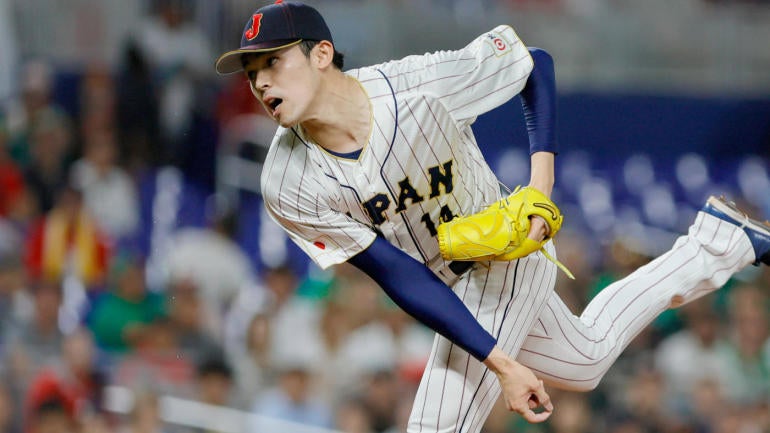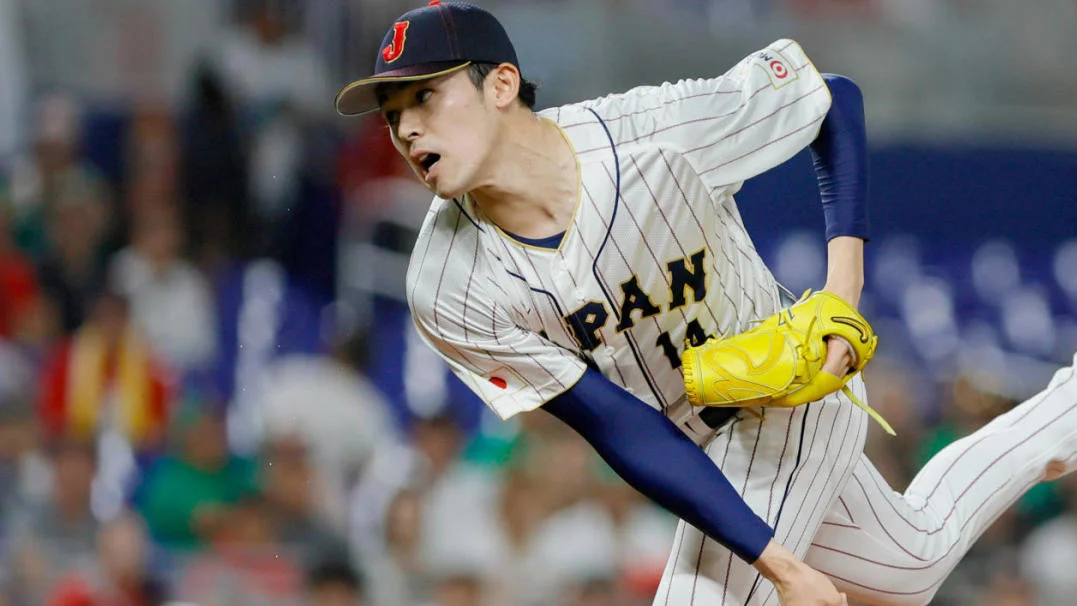
Turns out Roki Sasaki’s choice is exactly the one everyone expected him to make. On the day I revealed him to be my No. 1 prospect, just ahead of Roman Anthony, he announced that he’s signing with the Dodgers.
How does this change things for him in Fantasy? Well, shoot, he’s only now being added to the player pool. Let’s look into who he is first.
Sasaki was a wunderkind in Japan, reaching triple digits while in high school and being drafted first overall in 2019. He dominated from the time he debuted in 2021 and became internationally known with his splashy performance in the World Baseball Classic two years later. Thus began the countdown for him reaching the majors, and apparently he was unwilling to wait until age 25, when he could sign a legitimate free agent contract. Instead, he had to settle for the maximum allowed signing bonus through the international amateur pool, which effectively eliminated the Dodgers’ financial advantage over every other team.
But to the Dodgers he goes anyway, putting him under their control for at least the next six years, just like any other minor-league call-up. That part is worth stressing not just to marvel at their latest financial windfall but also to remind you where Sasaki stands developmentally. At 23, he’s not a finished product, still working to refine his arsenal and improve the consistency on his fastball.
In fact, one possible reason why he chose the Dodgers (one, not all) is their fluency in pitch design. The biggest concern in Sasaki’s scouting report is that his fastball dipped into the mid-to-high-90s range, possibly related to a bout with shoulder fatigue. In a vacuum, that’s still plenty of velocity, but the pitch’s secondary characteristics aren’t great, making it hittable when the velocity is less than elite. To maximizes his outcomes, then, Sasaki either needs to improve his fastball shape, which is the harder route but theoretically possible, or regain its velocity, which, again, may be just a matter of improved health.
Of course, his fastball is only secondary to his splitter, described by some evaluators as the best in the world. You can see from this video just how little it spins, causing it to drop into oblivion.
The splitter may be good enough on its own that he doesn’t need an elite fastball, particularly now that he’s begun to mix in a slider more, but the concerns over the fastball are one reason why you should be careful not to overrate Sasaki for 2025.
The other reason is that, well, he signed with the Dodgers. Here’s where we explore the pros and cons of that decision.
Pro: He’s with an organization that excels at player development and pitch design.
We’ve already covered this, but as a point of clarification, it mostly applies to his long-term trajectory.
Con: He’s with an organization that doesn’t so much need him right now.
That’s not to say he won’t break camp with the team or make a meaningful number of starts, but the Dodgers are going to the playoffs with or without him and, thus, have the luxury of handling him with kid gloves. Even from the standpoint of “covering the innings,” this is true. Yoshinobu Yamamoto, Blake Snell and Tyler Glasnow are expected to occupy the first three spots in the Dodgers rotation, with Shohei Ohtani eventually joining them, but the Dodgers can also mix in Bobby Miller, Tony Gonsolin, Dustin May, Landon Knack, Michael Grove and Justin Wrobleski to keep everyone healthy and rested, giving them a whole rotation’s worth of viable alternatives. A team like the Padres or Blue Jays would have had to lean on Sasaki more to get where they want to get, which would have been better for his immediate value.
Pro: He’s with the organization that maximizes his win potential.
This is true in theory, anyway. The Dodgers are poised for 100-plus wins, and any time Sasaki pitches reasonably well over five-plus innings, he’s bound to be the recipient. Of course, the volatility of bullpens and the unpredictable distribution of runs over the course of a game also play a role here, but to the degree we can predict such things, we can predict a bunch of wins for Sasaki … in theory.
Con: He’s with the organization best equipped to limit his innings.
I keep saying “in theory” because, again, the Dodgers are going to the playoffs with or without Sasaki. In the playoffs is where they need him most, and above and beyond that, they’ll want to preserve his longevity as they would any recent call-up. That’s especially true because he already comes with a bit of an injury history, having never thrown even 130 innings in a season.
None of Yamamoto, Snell, Glasnow or Ohtani is a bastion of health either, and I think the Dodgers will be careful with them, too. But their incredible rotation depth allows them to be careful with everyone, by which I mean they’ll probably never be in a position where they have to start Sasaki. Early hooks, often after just five innings, and occasional shutdowns should be the expectation in his rookie season, such that I’m not comfortable predicting him to reach that 130-inning threshold for the first time. He’ll likely excel with the innings he gets, but in the end, you may view him as more of a headache than an asset.
Between those usage concerns and the mystery surrounding his fastball, I prefer to play it safe with Sasaki in redraft leagues, ranking him only 39th among starting pitchers to start out. That’s well below NFBC ADP, where he’s currently 18th, but I think publicity is mostly driving that number. Signing with the Dodgers may only exacerbate the issue.
No. 1 prospect, though!



